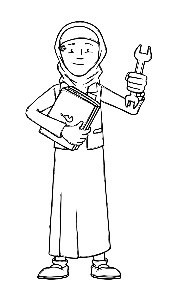Engineers at Queen's Crescent
Being a Design & Technology Engineer
Lead Engineer: Mrs Kelly Butt
Intent:
Design and technology is an inspiring, rigorous and practical subject. Children are encouraged to use their creativity and imagination, to design and make products that solve real and relevant problems within a variety of contexts, considering their own and others’ needs, wants and values. We want our children to acquire a broad range of subject knowledge and draw on disciplines such as mathematics, science, engineering, computing and art.
Our pupils learn how to take risks, becoming resourceful, innovative, enterprising and capable citizens. Through the evaluation of past and present design and technology, they develop a critical understanding of its impact on daily life and the wider world. High-quality design and technology education makes an essential contribution to the creativity, culture, wealth and well-being of the nation.
Aims:
The national curriculum for design and technology aims to ensure that all pupils:
- develop the creative, technical and practical expertise needed to perform everyday tasks confidently and to participate successfully in an increasingly technological world
- build and apply a repertoire of knowledge, understanding and skills in order to design and make high-quality prototypes and products for a wide range of users
- critique, evaluate and test their ideas and products and the work of others
- understand and apply the principles of nutrition and learn how to cook.
 |
 |
How do we teach DT and why has this approach been chosen?
Design & Technology is taught through our enquiry-led curriculum (see ‘Our Curriculum’ section of the website). As ‘Engineers’ pupils learn the relevant disciplinary and substantive knowledge and then apply it through an enquiry challenge. Enquiries are carefully planned to ensure they are meaningful, localised (where possible) and progressive. Teachers make it explicit to the children that they are learning design & technology skills and encouraging them to think like ‘Engineers’.
Our design & technology curriculum progression girds are used in order to ensure disciplinary and substantive knowledge build year on year. This ensures that by the end of year 6, pupils have the skills and knowledge to support their future studies.
What our design & technology lessons involve:
| Re-cap prior knowledge |
These information recall activities may involve :
|
| New information presented in small and simple steps |
Children are then given time to practise applying the new knowledge, in an effort to support working memory. |
| Teachers pose carefully considered questions |
This allows pupils to deepen their understanding. |
| Clear modelling |
Teacher demonstrate a new concept or approach to learning. |
| Scaffolding |
Children’s activities are matched to their needs. The learning is broken up into chunks and pupils are provided with the tools and structures needed to be successful. |
| Working Walls |
These are used to display the learning journey through an enquiry. |
Children’s learning is documented in enquiry books
Engineering outcomes:
Design and technology is monitored by the Engineer lead throughout the year in the form of book looks, lesson observations and pupil conferencing. Classroom displays evidence the work the children have completed throughout a design unit.
Teachers continually assess children in design & technology lessons and complete an enquiry assessment at the end of each enquiry. Progression grids act as a reference for end of year expectations for each year group and teachers are aware of the entry and exit points for their children.
The lead engineer works closely with the link governor to assess the impact of design & technology curriculum each year.









